Sources
- Paul the Deacon. Historia Langobardorum. Translated by William Dudley Foulke. University of Pennsylvania: 1907.
- Hodgkin, Thomas. Italy and her Invaders. Clarendon Press: 1895.
Ansfrid, Ansfrit, or Ausfrid was the Duke of Friuli in 694. He was originally the lord of the castle of Ragogna.
In 694, he attacked Friuli and forced Duke Rodoald to flee to King Cunipert. Ansfrid then rebelled against the king in an attempt to make himself sovereign. He invaded Verona, but was there captured and brought before the king. He was blinded and exiled. Rodoald's brother Ado was invested in the Friulian dukedom.

Year 799 (DCCXCIX) was a common year starting on Tuesday of the Julian calendar. The denomination 799 for this year has been used since the early medieval period, when the Anno Domini calendar era became the prevalent method in Europe for naming years.

Year 694 (DCXCIV) was a common year starting on Thursday of the Julian calendar. The denomination 694 for this year has been used since the early medieval period, when the Anno Domini calendar era became the prevalent method in Europe for naming years.

Arnulf II, also known as the Bad, the Evil or the Wicked, a member of the Luitpolding dynasty, held the title of Duke of Bavaria from about 907 until his death in 937. He is numbered in succession to Arnulf of Carinthia, counted as Arnulf I.

Rothari, of the house of Arodus, was king of the Lombards from 636 to 652; previously he had been duke of Brescia. He succeeded Arioald, who was an Arian like himself, and was one of the most energetic of Lombard kings. Fredegar relates that at the beginning of his reign he put to death many insubordinate nobles, and that in his efforts for peace he maintained very strict discipline.
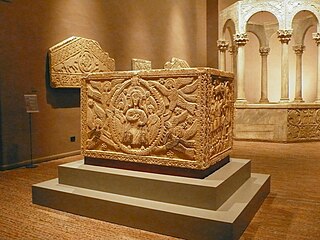
Ratchis was the Duke of Friuli (739–744) and then King of the Lombards (744–749).

Nonantola Abbey, dedicated to Saint Sylvester, is a former a Benedictine monastery and prelature nullius in the commune of Nonantola, c. 10 km north-east of Modena, in the Emilia Romagna region of Italy. The abbey church remains as a basilica and is the co-cathedral of the diocese of Modena-Nonantola.
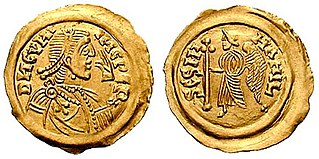
Cunincpert was king of the Lombards from 688 to 700. He succeeded his father Perctarit, though he was associated with the throne from 680.
Grimoald or Grimwald (†671) was a 7th-century King of Italy, ruling as Duke of Benevento from 647 to 662, and then as King of the Lombards from 662 until his death in 671.
The dukes and margraves of Friuli were the rulers of the Duchy and March of Friuli in the Middle Ages.
Gisulf II was the Duke of Friuli from around 591 to his death. He was the son and successor of Grasulf I of Friuli.
Lupus was the Duke of Friuli from between 660 and 663 to his death around 666.
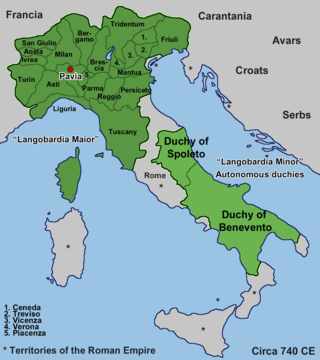
The Duchy of Friuli was a Lombard duchy in present-day Friuli, the first to be established after the conquest of the Italian peninsula in 568. It was one of the largest domains in Langobardia Major and an important buffer between the Lombard kingdom and the Slavs, Avars, and the Byzantine Empire. The original chief city in the province was Roman Aquileia, but the Lombard capital of Friuli was Forum Julii, modern Cividale.
Landar, Landari, or Laudari(s) was the Duke of Friuli following Wechthari in 678. He himself died before 694, when Rodoald appears as his successor.
Rodoald or Rodwald was the Duke of Friuli following Landar in the late seventh century. The precise dates of his reign cannot be known.
Ado was the Duke of Friuli after the usurper Ausfrid was defeated at Verona in 694. According to Paul the Deacon, he was a brother of the former duke Rodoald and ruled for a year and seven months. The actual length of his reign is disputed, as is the year of its occurrence. He appears with the title loci servator (caretaker) and may have only held the duchy as regent on behalf of the king.
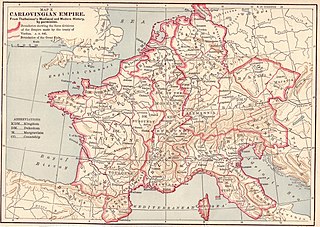
The March of Friuli was a Carolingian frontier march, established in 776 as the continuation of the Lombard Duchy of Friuli, established against the Slavs and Avars. It was ceded to the Duchy of Bavaria as the March of Verona in 952. Its territory comprised parts of modern-day Italy, Slovenia and Croatia.

The County of Huy was a division of Lotharingia during the early Middle Ages, centred on the town of Huy and its citadel overlooking the Meuse.
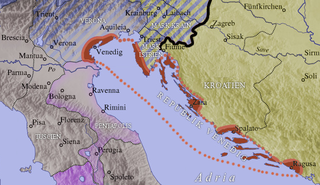
The March of Istria was originally a Carolingian frontier march covering the Istrian peninsula and surrounding territory conquered by Charlemagne's son Pepin of Italy in 789. After 1364, it was the Istrian province of the Habsburg monarchy, the Austrian Empire and Austria-Hungary.
Ansfrid may refer to:
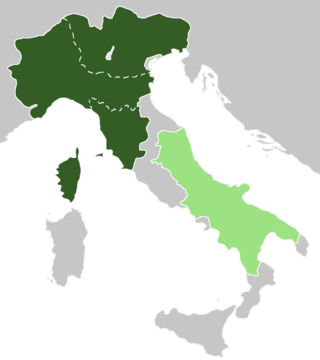
Austria was, according to the early medieval geographical classification, the eastern portion of Langobardia Major, the north-central part of the Lombard Kingdom, extended from the Adda to Friuli and opposite to Neustria. The partition had not only been territorial, but also implied significant cultural and political differences.